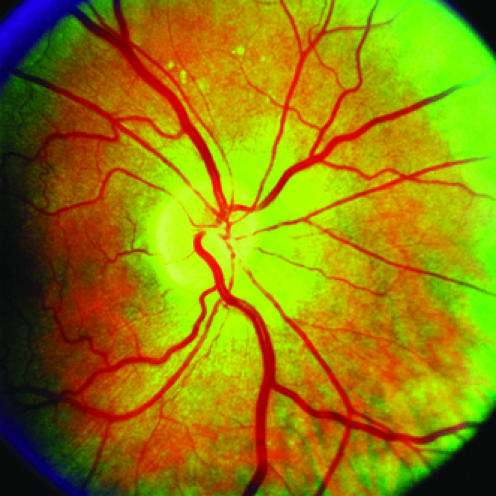Editor—Wong et al studied the association between retinal vessel diameters and risk of hypertension.1 Some points would have deserved discussion.
Figure 1.


Narrowed (left) and normal (right) retinal arterioles
Firstly, evidence shows that blood pressure is one of the strongest predictors of the risk of progression towards hypertension. Thus, in the Framingham cohort study,2 subjects with a normal blood pressure (120-129/80-84 mm Hg) had a twofold to fourfold increased risk of hypertension as subjects with optimum blood pressure (< 120/80 mm Hg). Subjects with a high normal pressure (135-139/85-89 mm Hg) had fivefold to 12-fold raised odds. These figures were obtained only after four years of follow up.2
The odds ratios found by Wong et al were lower despite a longer follow up period. Moreover, with increasing retinal arteriole narrowing, the risk difference between normal and prehypertensive subjects disappeared. Do these findings indicate that, among patients in the first fourth of the arteriole-venule ratio, blood pressure is no longer a determinant of hypertension risk? This raises questions about the validity of the findings by Wong et al.
Secondly, again in the Framingham cohort study, the change in weight was a clear determinant of the risk of hypertension: a 5% weight gain was associated with 20-30% increased odds of the incidence of hypertension.2 Weight change was not measured in the study by Wong et al. This change would have been a pertinent variable to consider for the multivariate analysis.
I am therefore not sure of the clinical pertinence of this study: before assessing arteriolar narrowing among my patients, I would prefer to measure their blood pressure carefully and to follow their change in weight to evaluate their risk of hypertension (and other health risks).
Competing interests: None declared.
References
- 1.Wong TY, Shankar A, Klein R, Klein BE, Hubbard LD. Prospective cohort study of retinal vessel diameters and risk of hypertension. BMJ 2004;329: 79-82. (10 July.) [DOI] [PMC free article] [PubMed] [Google Scholar]
- 2.Vasan RS, Larson MG, Leip EP, Kannel WB, Levy D. Assessment of frequency of progression to hypertension in non-hypertensive participants in the Framingham heart study: a cohort study. Lancet 2001;358: 1682-6. [DOI] [PubMed] [Google Scholar]


